Site Control: Difference between revisions
(template) |
(some tuneup) |
||
| Line 1: | Line 1: | ||
Site control is a | '''Site control''' is a formal game term. Some [[Shadow Alignment|Shadow]] cards can "take control of a site," thematically representing the enemies of Middle-Earth occupying or overrunning that location. This isn't permanent, because cards can later '''liberate''' that site. When you control a site, take the lowest-numbered uncontrolled [[site]] in the site path and put it in your [[support area]]. If your opponent liberates a site, you take the highest-numbered site you control (if any) and put it back on the site path where it was before. Sites can only be controlled once both players' [[Fellowship]] has passed them by, and each site can only be controlled by one player at a time. (Any effect that would control a site when there is no legal site to control is wasted.) Controlling a site doesn't give any inherent benefits, but many Shadow cards want to [[spot]] controlled sites, or [[stack]] other cards on them for benefits. | ||
This mechanic was introduced in [[The Two Towers]], and appears in almost all later sets. Most Shadow [[culture]]s have at least some site control cards, including {{C|Isengard}}, {{C|Dunland}}, {{C|Sauron}} (the [[besieger]] subculture focuses on this), {{C|Men}}, and {{C|Uruk-hai}}. The {{C|Raider}} culture has a few cards that deal with site control, but these are few and far between and only one, {{Card|Southron Archer}}, is of any real worth. | |||
Once the Shadow player has controlled a site, the opposing [[Free Peoples]] player can liberate them. {{C|Elven}}, {{C|Gondor}}, and {{C|Rohan}} cultures have some of the best liberation cards, like {{Card|That is no Orc Horn}}, {{Card|Elendil, The Tall}}, {{Card|Banner of Westernesse}}, {{Card|Let Us Be Swift}}, {{Card|Fell Deeds Awake}}, and {{Card|Rohan Worker}}. | |||
==Rules Entries== | |||
{{RulesQuote | |||
|source=control | |||
|text=Shadow players may use effects to take control of sites on the adventure path. When you take control of a site, place that site in your support area, lengthwise. | |||
A controlled site, once placed in a player's support area, is no longer a site on the adventure path. | A controlled site, once placed in a player's support area, is no longer a site on the adventure path. | ||
| Line 7: | Line 14: | ||
A Shadow player may only take control of a site on the adventure path if all player markers are on sites with higher site numbers. | A Shadow player may only take control of a site on the adventure path if all player markers are on sites with higher site numbers. | ||
When all player markers are at site 2 or higher, you may take control of site 1. | ''When all player markers are at site 2 or higher, you may take control of site 1.'' | ||
When a Shadow player takes control of a site, the site on the adventure path with the lowest site number must be selected. | When a Shadow player takes control of a site, the site on the adventure path with the lowest site number must be selected. | ||
An opponent controls site 1 and all player markers are at site 3 or higher, so you must take control of site 2. | ''An opponent controls site 1 and all player markers are at site 3 or higher, so you must take control of site 2.'' | ||
The game text of a controlled site cannot be used by any player. Exception: The keywords of a controlled site still apply. | The game text of a controlled site cannot be used by any player. Exception: The keywords of a controlled site still apply. | ||
A player may "control a battleground." | ''A player may "control a battleground."'' | ||
When your opponent controls a site from your adventure deck, it's still your site. Some cards can replace a controlled site. Move any cards stacked on the site being replaced to the new site, then return the old site to its owner's adventure deck. | |||
When your opponent controls a site from your adventure deck, it's still your site. Some cards can replace a controlled site. Move any cards stacked on the site being replaced to the new site, then return the old site to its owner's adventure deck.}} | |||
{{RulesQuote | |||
|source=liberate | |||
|text=A Free Peoples player may have a card effect that allows him to liberate a site. Only a site that another player controls may be liberated. You cannot liberate a site on the adventure path, a site in any adventure deck, or a site you control. | |||
When you liberate a site, place it back on the adventure path. Any cards on that site are discarded. You must liberate the site with the highest site number controlled by one of your opponents first, regardless of which opponent controls that site. (If you control the site with the highest site number, you must liberate the next highest site controlled by an opponent.) }} | |||
==Cards That Control Sites== | ==Cards That Control Sites== | ||
Revision as of 00:49, 17 January 2022
Site control is a formal game term. Some Shadow cards can "take control of a site," thematically representing the enemies of Middle-Earth occupying or overrunning that location. This isn't permanent, because cards can later liberate that site. When you control a site, take the lowest-numbered uncontrolled site in the site path and put it in your support area. If your opponent liberates a site, you take the highest-numbered site you control (if any) and put it back on the site path where it was before. Sites can only be controlled once both players' Fellowship has passed them by, and each site can only be controlled by one player at a time. (Any effect that would control a site when there is no legal site to control is wasted.) Controlling a site doesn't give any inherent benefits, but many Shadow cards want to spot controlled sites, or stack other cards on them for benefits.
This mechanic was introduced in The Two Towers, and appears in almost all later sets. Most Shadow cultures have at least some site control cards, including Isengard,
Dunland,
Sauron (the besieger subculture focuses on this),
Men, and
Uruk-hai. The
Raider culture has a few cards that deal with site control, but these are few and far between and only one, Southron Archer (4R245)
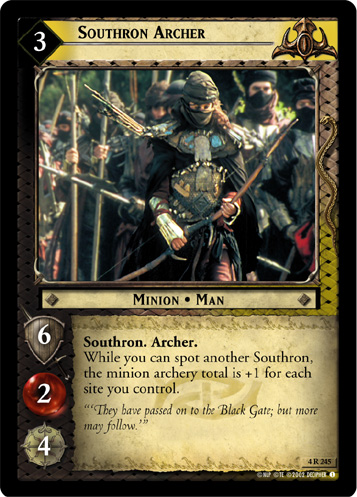 , is of any real worth.
, is of any real worth.
Once the Shadow player has controlled a site, the opposing Free Peoples player can liberate them. Elven,
Gondor, and
Rohan cultures have some of the best liberation cards, like That Is No Orc Horn (5C14)
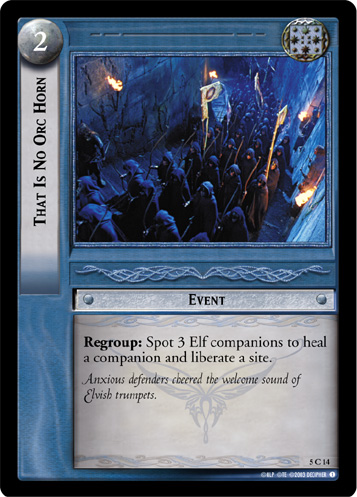 , Elendil, The Tall (9R+32)
, Elendil, The Tall (9R+32)
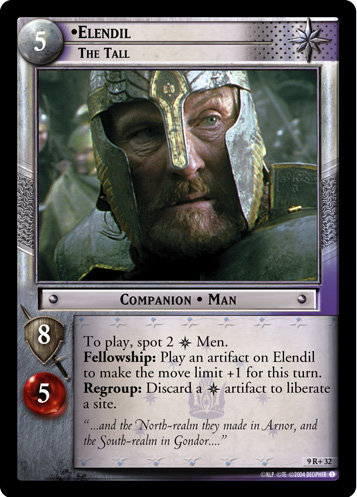 , Banner of Westernesse (6U51)
, Banner of Westernesse (6U51)
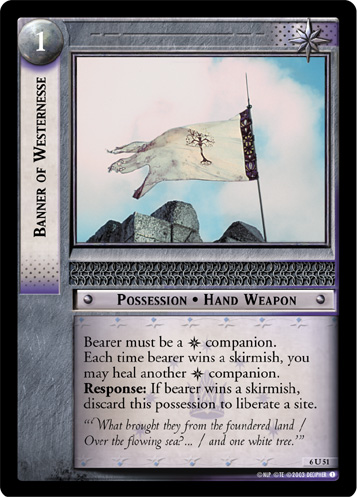 , Let Us Be Swift (5C85)
, Let Us Be Swift (5C85)
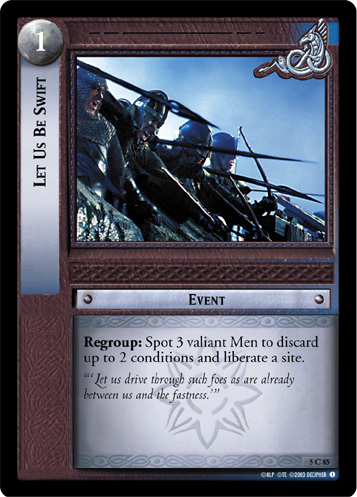 , Fell Deeds Awake (10U73)
, Fell Deeds Awake (10U73)
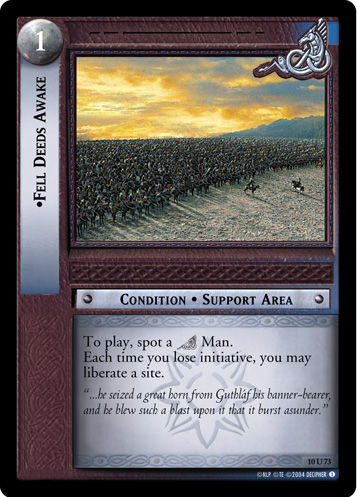 , and Rohan Worker (15R135)
, and Rohan Worker (15R135)
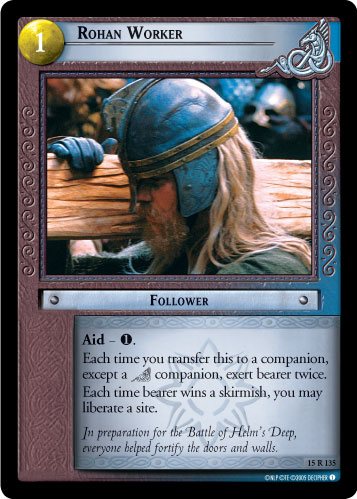 .
.
Rules Entries
Shadow players may use effects to take control of sites on the adventure path. When you take control of a site, place that site in your support area, lengthwise.
A controlled site, once placed in a player's support area, is no longer a site on the adventure path.
A Shadow player may only take control of a site on the adventure path if all player markers are on sites with higher site numbers.
When all player markers are at site 2 or higher, you may take control of site 1.
When a Shadow player takes control of a site, the site on the adventure path with the lowest site number must be selected.
An opponent controls site 1 and all player markers are at site 3 or higher, so you must take control of site 2.
The game text of a controlled site cannot be used by any player. Exception: The keywords of a controlled site still apply.
A player may "control a battleground."
When your opponent controls a site from your adventure deck, it's still your site. Some cards can replace a controlled site. Move any cards stacked on the site being replaced to the new site, then return the old site to its owner's adventure deck.- control section
A Free Peoples player may have a card effect that allows him to liberate a site. Only a site that another player controls may be liberated. You cannot liberate a site on the adventure path, a site in any adventure deck, or a site you control. When you liberate a site, place it back on the adventure path. Any cards on that site are discarded. You must liberate the site with the highest site number controlled by one of your opponents first, regardless of which opponent controls that site. (If you control the site with the highest site number, you must liberate the next highest site controlled by an opponent.)
- liberate section